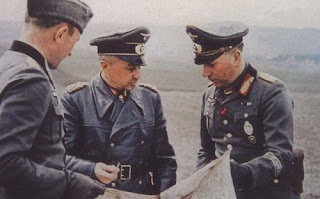The Molotov-Ribbentrop Pact 70 Years On
 Seventy years ago tomorrow (Sunday), the Soviet Union signed a pact with Nazi Germany that gave dictator Josef Stalin a free hand to take over part of Poland and the Baltic states on the eve of World War II.
Seventy years ago tomorrow (Sunday), the Soviet Union signed a pact with Nazi Germany that gave dictator Josef Stalin a free hand to take over part of Poland and the Baltic states on the eve of World War II.
Most of the world now condemns the Molotov-Ribbentrop Pact, but Russia has recently mounted a new defence of the 1939 treaty as it seeks to restore some of its now-lost sphere of influence, and this has very interesting implications for Russia-watchers in the current climate.
The pact, formally a treaty of nonaggression, was signed 23rd August 1939, in Moscow by Vyacheslav Molotov and Joachim von Ribbentrop, the foreign ministers of the two countries. In addition to the pledge of nonaggression, the treaty included secret protocols that divided eastern Europe into German and Soviet spheres of influence.
On Sept. 1, Germany invaded Poland — thus igniting World War II — and within weeks the Red Army had marched in from the east. After claiming its part of Poland, the Soviet Union then annexed part of Finland, the Baltic states and the Romanian region that is now Moldova.
The Soviet Union officially denied the existence of the secret protocols for decades. They were only formally acknowledged and denounced in 1989. But as the 70th anniversary of the treaty has approached, some Russian historians, acting it seems as proxies of the current leadership, have stepped up to defend the Soviet Union’s decision to expand its territory at the expense of its neighbours.
The Foreign Intelligence Service, once part of the KGB, recently published a book of declassified intelligence reports in an effort to make the case that the nonaggression treaty and its secret protocols were justified and essential to the victory over the Nazis. The idea was to move Soviet borders with Germany to the West to prevent the Baltic states of Lithuanian, Latvia and Estonia from becoming a staging ground for an attack. Even so, when Nazi Germany did attack in June 1941, all the territory the Soviet Union had gained was lost in a matter of weeks.
At the end of the war, however, U.S. and British leaders accepted the borders of the Soviet Union as defined by the treaty with Germany. This in effect restored the borders of the Russian Empire. The Allied leaders also allowed Stalin to extend the Soviet Union’s sphere of influence throughout much of eastern and central Europe.
The current attempt to justify the carving up of Europe during World War II comes as Russia once again is trying to establish its sphere of influence.
After last year’s conflict with Georgia, a U.S. ally, President Dmitry Medvedev asserted Russia’s right to intervene militarily in what it regards as its zone of “privileged interests” along its borders. The war stripped Georgia of pieces of its territory, which are now under the control of Russian-backed separatists.
“In his understanding of Realpolitik, Vladimir Putin does not diverge from the line set by Josef Stalin,” military analyst Alexander Golts wrote in the online Yezhednevny Zhurnal. “Military force decides everything and if there is an opportunity to grab a piece of someone else’s territory then it should be taken.”
Moscow has insisted it should have a dominating influence over countries that were once part of the Soviet Union. But Washington has continued to encourage the NATO ambitions of Georgia and Ukraine, and has made clear that it will accept no claims of a Russian sphere of influence over former Soviet republics that are now sovereign states.
Russians’ defense of the Molotov-Ribbentrop Pact also is being used to bolster the Kremlin’s push for the creation of a new collective security system to replace NATO, embracing all of Europe, the United States and Canada.
As Russia rearms and increasingly flexes its diplomatic and military muscles in the face of a weak leader in the White House then prepare to see further territorial skirmishes along Russia’s borders and aggressive diplomatic moves overseas. The Monroe Doctrine has long been forgotten and on this anniversary take the opportunity to read between the lines of news stories and notice the Great Bear stirring again.

I think we all know what this means! It’s time for another apology from Obama! I think I hear airforce one being fired up as I type this.